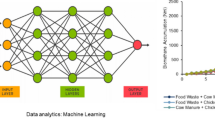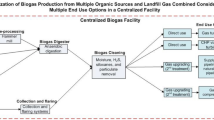Abstract
High population spikes have been projected for develo** countries in the nearest future. This development is a source of concern as there are no visible futuristic economic agenda to douse the menace of population growth in a dying economy. This paper is a blueprint for standalone energy users and the built industry to improve energy generation using sustainable materials, i.e., human and agro waste. This research examines two popular agro waste i.e., plantain peel and Siam leave. The concept of bio-digester septic tank design (BDSTD) was also discussed. Biogas from plantain-faecal (PF) had a higher cumulative production than biogas from Siam-faecal (SF) because plantain biomass aids initial bio-digestion of the faecal samples due to its inherent chemical components which are important to breaking undigested food component in the faecal mass. In this wise, the chemical component in Siam biomass cannot easily break undigested food components in the faecal mass. However, SF creates a better enabling environment for microbial growth that could lead to about 400% biogas generation over PF and 160% biogas generation over pure faecal (TF). Despite this feat, the caveat for improved daily gas production rate in SF is hinged on pre-processing of the faecal mass. With the aid of machine learning, it was revealed that higher retention time could be a natural way of pre-processing needed by the Siam biomass. This concept led to the design of the BDSTD which was technically hinged on cross-sectional partitions. Plantain biomass is recommended for four partitions BDSTD design as there would be shorter retention time in the overflow chamber while the Siam biomass is recommended for > 4 partitions BDSTD designs.
Graphical Abstract












Similar content being viewed by others
Data Availability
Enquiries about data availability should be directed to the authors.
References
Oteman, M., Wiering, M., Helderman, J.K.: The institutional space of community initiatives for renewable energy: a comparative case study of the Netherlands, Germany and Denmark. Energy Sustain. Soc. 4(1), 1–17 (2014)
Abanihi, V.K., Ikheloa, S.O., Okodede, F.: Overview of the Nigerian power sector. Am. J. Eng. Res. 7(5), 253–263 (2018)
Aliyu, A.S., Dada, J.O., Adam, I.K.: Current status and future prospects of renewable energy in Nigeria. Renew. Sustain. Energy Rev. 48, 336–346 (2015)
Akinbami, J., Lawal, A.: Opportunities and challenges to electrical energy conservation and CO2 emissions reduction in Nigeria’s building sector. Cities Clim. Change 2, 345–365 (2009)
IRENA: Renewable Capacity Statistics 2018, https://www.irena.org/publications/2018/mar/renewable-capacity-statistics-2018 (2018). Accessed 23 Sept 2022
Deublein, D., Steinhauser, A.: Biogas from Waste and Renewable Resources: An Introduction, pp. 89–290. Wiley-VCH, Weinheim (2008)
Mukherjee, S., Sensharma, D., Chen, K.J., Zaworotko, M.J.: Crystal engineering of porous coordination networks to enable separation of C2 hydrocarbons. Pubs. Rsc. Org 56, 10519 (2020). https://doi.org/10.1039/D0CC04645K
Perera, F.: Pollution from fossil-fuel combustion is the leading environmental threat to global pediatric health and equity: solutions exist. Int. J. Environ. Res. Public Health 15(1), 16 (2018). https://doi.org/10.3390/IJERPH15010016
Ilori, M.O., Adebusoye, S.A., Iawal, A.K., Awotiwon, O.A.: Production of biogas from banana and plantain peels. Adv. Environ. Biol. 1, 33–39 (2007)
Andriani, D., Wresta, A., Saepudin, A., Prawara, B.: A review of recycling of human excreta to energy through biogas generation: Indonesia case. Energy Procedia 68, 219–225 (2015)
Akindayo, A.S.: Municipal solid waste management and the inland water bodies: Nigerian perspectives. https://doi.org/10.5772/intechopen (2019)
Omer, A.: Biogas technology for sustainable energy generation: development and perspectives. MOJ App Bio Biomech. 1(4), 137–148 (2017)
Emetere, M.E., Chikwendu, L., Afolalu, S.A.: Improved biogas production from human excreta using chicken feather powder: a sustainable option to eradicating poverty. Glob. Chall. 2100117, 1–11 (2022)
National Population Commission (NPC): Figures. Accessed January, 2015. www.npc.gov.gn. (2006). Accessed 1 Aug 2022
Garcıa-Aljaro, C., Blanch, A.R., Campos, C., Jofre, J., Lucena, F.: Pathogens, faecal indicators and human-specific microbial source-tracking markers in sewage. J. Appl. Microbiol. 126, 701–717 (2018)
Auchtung, T.A., Fofanova, T.Y., Stewart, C.J., Nash, A.K., Wong, M.C., Gesell, J.R., Auchtung, J.M., Ajami, N.J., Petrosino, J.F.: Investigating colonization of the healthy adult gastrointestinal tract by fungi. mSphere 3(2), 1–16 (2018)
Forbes, D., Ee, L., Camer-Pesci, P., Ward, P.B.: Faecal candida and diarrhoeal. Arch. Dis. Child. 84(4), 328–331 (2001)
Kumari, S., Ambasta, S.K.: Isolation of microorganisms from stool sample of diarrhoea patient and effect of antibiotics and herbal extract. CIBTech J. Microbiol. 2(2), 24–32 (2013)
Hallen-Adams, H.E., Suhr, M.J.: Fungi in the healthy human gastrointestinal tract. Virulence 8, 352–358 (2017)
Letarov, A., Kulikov, E.: The bacteriophages in human- and animal body-associated microbial communities. J. Appl. Microbiol. 107, 1–13 (2009)
Karu, N., Deng, L., Slae, M., Guo, A.C., Sajed, T., Huynh, H., Wine, E., Wishart, D.S.: A review on human fecal metabolomics: methods, applications and the human fecal metabolome database. Anal. Chim. Acta 1030, 1–24 (2018). https://doi.org/10.1016/J.ACA.2018.05.031
Abdel-Shafy, H.I., Mansour, M.S.M.: Solid waste issue: sources, composition, disposal, recycling, and valorization. Egypt. J. Pet. 27(4), 1275–1290 (2018). https://doi.org/10.1016/J.EJPE.2018.07.003
Penn, R., Ward, B.J., Strande, L., Maurer, M.: Review of synthetic human faeces and faecal sludge for sanitation and wastewater research. Water Res. 132, 222–240 (2018). https://doi.org/10.1016/j.watres.2017.12.063
Ma, N., Guo, P., Zhang, J., He, T., Kim, S.W., Zhang, G., Ma, X.: Nutrients mediate intestinal bacteria-mucosal immune crosstalk. Front. Immunol. 9, 5 (2018). https://doi.org/10.3389/fimmu.2018.00005
Volk, T., Rummel, J.D.: Mass balances for a biological life support system simulation model. Adv. Space Res. 7(4), 141–148 (1987)
Wisniewski, P.J., Dowden, R.A., Campbell, S.C.: Role of dietary lipids in modulating inflammation through the gut microbiota. Nutrients 11(1), 117 (2019). https://doi.org/10.3390/NU11010117
Afolabi, O.O.D., Sohail, M.: Microwaving human faecal sludge as a viable sanitation technology option for treatment and value recovery: a critical review. J. Environ. Manag. 187, 401–415 (2017). https://doi.org/10.1016/J.JENVMAN.2016.10.067
Krueger, B., Fowler, G., M. T.-J. of E.: Faecal sludge pyrolysis: Understanding the relationships between organic composition and thermal decomposition. Elsevier. https://www.sciencedirect.com/science/article/pii/S0301479721015188. (2021). Accessed 7 June 2022
Yan, Z., Zhao, H., Zhao, Y., Zhu, Q., Qiao, R., Ren, H., Zhang, Y.: An efficient method for extracting microplastics from feces of different species. J. Hazard. Mater. 384, 121489 (2020). https://doi.org/10.1016/J.JHAZMAT.2019.121489
Zhao, X., McHugh, C., Coffey, S.R., Jimenez, D.A., Adams, E., Carroll, J.B., Usdin, K.: Stool is a sensitive and noninvasive source of DNA for monitoring expansion in repeat expansion disease mouse models. Dis. Models Mech. (2022). https://doi.org/10.1242/DMM.049453
Bellali, S., Lagier, J.C., Raoult, D., Khalil, J.B.: Among live and dead bacteria, the optimization of sample collection and processing remains essential in recovering gut microbiota components. Front. Microbiol. 10, 1606 (2019). https://doi.org/10.3389/FMICB.2019.01606/BIBTEX
Ser, H.L., Letchumanan, V., Goh, B.H., Wong, S.H., Lee, L.H.: The use of fecal microbiome transplant in treating human diseases: too early for poop? Front. Microbiol. 12, 1005 (2021). https://doi.org/10.3389/FMICB.2021.519836/BIBTEX
Cyprowski, M., Stobnicka-Kupiec, A., Ławniczek-Wałczyk, A., Bakal-Kijek, A., Gołofit-Szymczak, M., Górny, R.L.: Anaerobic bacteria in wastewater treatment plant. Int. Arch. Occup. Environ. Health 91(5), 571 (2018). https://doi.org/10.1007/S00420-018-1307-6
Greene, J.P.: Degradation and biodegradation standards for biodegradable food packaging materials. Ref. Modul. Food Sci. (2019). https://doi.org/10.1016/B978-0-08-100596-5.22437-2
EPA: EPA Releases 2021 Data Collected under Greenhouse Gas Reporting Program. https://www.epa.gov/newsreleases/epa-releases-2021-data-collected-under-greenhouse-gas-reporting-program (2021). Accessed 23 Sept 2022
Enzmann, F., Mayer, F., Rother, M., Holtmann, D.: Methanogens: biochemical background and biotechnological applications. AMB Express 8(1), 1 (2018). https://doi.org/10.1186/S13568-017-0531-X
Alemneh, T.: Review on methanogenesis and its role. World J. Agric. Soil Sci. 6(2), 50 (2020). https://doi.org/10.33552/WJASS.2020.06.000632
Buan, N.R.: Methanogens: pushing the boundaries of biology. Emerg. Top. Life Sci. 2(4), 629 (2018). https://doi.org/10.1042/ETLS20180031
Amin, F., Khalid, H., El-Mashad, H., C. C.-S. of T. T.: Functions of bacteria and archaea participating in the bioconversion of organic waste for methane production. Elsevier. https://www.sciencedirect.com/science/article/pii/S0048969720365372 (2021). Accessed 7 June 2022
Knobbe, T., Douwes, R., Kremer, D., J. S.-J. of clinical: altered gut microbial fermentation and colonization with Methanobrevibacter smithii in renal transplant recipients. Mdpi.Com. https://www.mdpi.com/641550 (2020). Accessed 7 June 2022
Chong, P.P., Chin, V.K., Looi, C.Y., Wong, W.F., Madhavan, P., Yong, V.C.: The microbiome and irritable bowel syndrome: a review on the pathophysiology, current research and future therapy. Front. Microbiol. 10, 100056 (2019). https://doi.org/10.3389/FMICB.2019.01136/FULL
Camara, A., Konate, S., Tidjani Alou, M., Kodio, A., Togo, A.H., Cortaredona, S., Henrissat, B., Thera, M.A., Doumbo, O.K., Raoult, D., Million, M.: Clinical evidence of the role of Methanobrevibacter smithii in severe acute malnutrition. Sci. Rep. 11(1), 1–11 (2021). https://doi.org/10.1038/s41598-021-84641-8
Wainaina, S., Lukitawesa, Kumar-Awasthi, M., Taherzadeh, M.J.: Bioengineering of anaerobic digestion for volatile fatty acids, hydrogen or methane production: a critical review. Bioengineered 10(1), 437–458 (2019). https://doi.org/10.1080/21655979.2019.1673937
Saber, M., Khitous, M., Kadir, L., Abada, S., N. T.-B.: Enhancement of organic household waste anaerobic digestion performances in a thermophilic pilot digester. Elsevier. https://www.sciencedirect.com/science/article/pii/S0961953420304657 (2021). Accessed 7 June 2022
Yang, B., Yin, F., Wang, C., Zhao, X., Liu, J., Wu, K., Yang, H., Zhang, W.: Construction of biogas metabolic pathway in a low-temperature biogas fermentation system. Energy Sci. Eng. 7(6), 3160–3173 (2019). https://doi.org/10.1002/ESE3.488
Modestra, J.A., Katakojwala, R., Mohan, S.V.: CO2 fermentation to short chain fatty acids using selectively enriched chemolithoautotrophic acetogenic bacteria. Chem. Eng. J. 394, 124759 (2020). https://doi.org/10.1016/J.CEJ.2020.124759
Cai, M., Wilkins, D., Chen, J., Ng, S.K., Lu, H., Jia, Y., Lee, P.K.H.: Metagenomic reconstruction of key anaerobic digestion pathways in municipal sludge and industrial wastewater biogas-producing systems. Front. Microbiol. 7, 778 (2016). https://doi.org/10.3389/FMICB.2016.00778/BIBTEX
Menzel, T., Neubauer, P., Junne, S.: Role of microbial hydrolysis in anaerobic digestion. Energies 13, 5555 (2020). https://doi.org/10.3390/en13215555
Zhang, B., Ning, D., Yang, Y., Nostrand, J. van, research, J. Z.-W.: Biodegradability of wastewater determines microbial assembly mechanisms in full-scale wastewater treatment plants. Elsevier. https://www.sciencedirect.com/science/article/pii/S0043135419310504 (2020). Accessed 7 June 2022
Paulo Alfons, J.M., Stams Diana, Z., Sousa, L.M.: Methanogens, sulphate and heavy metals: a complex system. Rev. Environ. Sci. Bio/Technol. (2015). https://doi.org/10.1007/s11157-015-9387-1
Vaisakh, M.N., Pandey, A.: The invasive weed with healing properties: a review on Chromolaena odorata. Int. J. Pharm. Sci. Res. 3(1), 80–81 (2012)
Okorie, D.O., Eleazu, C.O., Nwosu, P.: Nutrient and heavy metal composition of plantain (Musa paradisiaca) and banana (Musa paradisiaca) peels. J. Nutr. Food Sci. 5, 370 (2015). https://doi.org/10.4172/2155-9600.1000370
Kirumira Julius: Manage your waste with bio-digester, https://www.pinterest.com/pin/152348399881892431/ (2019)
Scott Leahy: The laundry alternative to learn about septic tanks. https://EzineArticles.com/expert/Scott_Leahy/24622 (2022)
Tilley, E., Ulrich, L., Lüthi, C., Reymond, P., Zurbrügg, C.: Compendium of Sanitation Systems and Technologies, 2nd edn. Swiss Federal Institute of Aquatic Science and Technology (EAWAG), Duebendorf (2014)
Valli Sarvani: Peepal waste managers set up a biogas plant. https://fusion.werindia.com/innovation/peepal-waste-managers-set-up-a-biogas-plant (2020)
Carol, R.: Microbial respiration, the engine of ocean deoxygenation. Front. Mar. Sci. (2019). https://doi.org/10.3389/fmars.2018.00533
Cordero, P.R., Bayly, K., Man Leung, P., Huang, C., Islam, Z.F., Schittenhelm, R.B., King, G.M., Greening, C.: Atmospheric carbon monoxide oxidation is a widespread mechanism supporting microbial survival. ISME J. 13, 2868–2881 (2019)
Meyer, O., Fiebig, K.: Enzymes oxidizing carbon monoxide. In: Degn, H., Cox, R.P., Toftlund, H. (eds.) Gas Enzymology. Springer, Dordrecht (1985)
Kraft, B., Strous, M., Tegetmeyer, H.E.: Microbial nitrate respiration–genes, enzymes and environmental distribution. J. Biotechnol. 155(1), 104–117 (2011). https://doi.org/10.1016/j.jbiotec.2010.12.025
Dahunsi, S.O., Oranusi, S., Efeovbokhan, V.E., Olayanju, A., Zahedi, S., Ojediran, J.O., Izebere, J.O., Aladegboye, O.J.: Anaerobic conversion of Chromolaena odorata (Siam weed) to biogas. Energy Rep. 4, 691–700 (2018). https://doi.org/10.1016/j.egyr.2018.10.006
Devi, M.K., Manikandan, S., Oviyapriya, M., Selvaraj, M., Assiri, M.A., Vickram, S., Subbaiya, R., Karmegam, N., Ravindran, B., Chang, S.W., Awasthi, M.K.: Recent advances in biogas production using Agro-Industrial Waste: a comprehensive review outlook of Techno-Economic analysis. Bioresource Technol. 363, 127871 (2022). https://doi.org/10.1016/j.biortech.2022.127871
Manjappa, K.: Use of eupatorium (Chromolaena odorata L.) in biogas production. Int. J. Sci. Eng. Res. 5(11), 869–873 (2014)
Funding
The authors have not disclosed any funding.
Author information
Authors and Affiliations
Corresponding author
Ethics declarations
Conflict of interest
The authors declare no conflict of interest.
Additional information
Publisher's Note
Springer Nature remains neutral with regard to jurisdictional claims in published maps and institutional affiliations.
Rights and permissions
Springer Nature or its licensor (e.g. a society or other partner) holds exclusive rights to this article under a publishing agreement with the author(s) or other rightsholder(s); author self-archiving of the accepted manuscript version of this article is solely governed by the terms of such publishing agreement and applicable law.
About this article
Cite this article
Emetere, M.E., Oniha, M.I., Chikwendu, L. et al. Enhanced Biogas Production from Human and Agro-Waste: Waste to Wealth Initiative. Waste Biomass Valor 15, 87–100 (2024). https://doi.org/10.1007/s12649-023-02139-y
Received:
Accepted:
Published:
Issue Date:
DOI: https://doi.org/10.1007/s12649-023-02139-y




